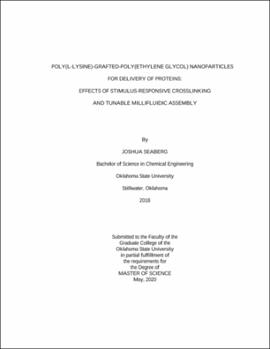| dc.contributor.advisor | Ramsey, Joshua | |
| dc.contributor.author | Seaberg, Joshua | |
| dc.date.accessioned | 2021-08-03T19:08:28Z | |
| dc.date.available | 2021-08-03T19:08:28Z | |
| dc.date.issued | 2020-05 | |
| dc.identifier.uri | https://hdl.handle.net/11244/330193 | |
| dc.description.abstract | Polymeric nanoparticles have drawn attention for their ability to enhance the efficacy of therapeutic proteins through reduced immunogenicity and extended circulation time. Nevertheless, nanoparticle drug delivery systems face hurdles in both application and production. The challenge of selective delivery to clinically-relevant locations can be addressed by integrating stimulus-responsive moieties into the nanoparticle structure. This study examined the effects of crosslinking nanoparticles of bovine serum albumin (BSA) encapsulated within poly(L-lysine)-grafted-poly(ethylene glycol) (PLL-g-PEG) with redox-responsive 3,3'-dithiobis(sulfosuccinimidyl propionate) (DTSSP) to achieve selective destabilization in a tumor environment. A library of DTSSP-crosslinked nanoparticles (DTSSP NPs) was formed with varying copolymer to protein (C:P) and crosslinker to protein (X:P) ratios, and each formulation was characterized by size, polydispersity index, and encapsulation efficiency. DTSSP NPs showed stability in the presence of serum and proteases, but rapidly destabilized when exposed to dithiothreitol. For therapeutic nanoparticle production, continuous processes have been proposed to overcome the challenges of poor scalability and few control parameters associated with batch synthesis. A millifluidic process was developed to encapsulate (BSA) in PLL-g-PEG through electrostatic self-assembly. The millifluidic process produced tunable nanoparticles (13 - 300 nm) that fully encapsulated the protein, retained its activity, and protected it from proteases. This thesis presents the utility of stimulus-responsive crosslinking for selective nanoparticle stabilization and proposes a millifluidic synthesis process for the production of nanoparticle drug delivery systems that may be foundational to the clinical translation of polymer-protein nanoparticles. | |
| dc.format | application/pdf | |
| dc.language | en_US | |
| dc.rights | Copyright is held by the author who has granted the Oklahoma State University Library the non-exclusive right to share this material in its institutional repository. Contact Digital Library Services at lib-dls@okstate.edu or 405-744-9161 for the permission policy on the use, reproduction or distribution of this material. | |
| dc.title | Poly(L-lysine)-grafted-poly(ethylene glycol) nanoparticles for delivery of proteins: Effects of stimulus-responsive crosslinking and tunable millifluidic assembly | |
| dc.contributor.committeeMember | Fahlenkamp, Heather | |
| dc.contributor.committeeMember | Aichele, Clint | |
| osu.filename | Seaberg_okstate_0664M_16673.pdf | |
| osu.accesstype | Open Access | |
| dc.type.genre | Thesis | |
| dc.type.material | Text | |
| dc.subject.keywords | comparison of continuous and batch processes | |
| dc.subject.keywords | millifluidic nanoparticle synthesis | |
| dc.subject.keywords | nanoparticle drug delivery | |
| dc.subject.keywords | poly(l-lysine)-grafted-poly(ethylene glycol) copolymer | |
| dc.subject.keywords | polymer-protein nanoparticle | |
| dc.subject.keywords | redox-responsive | |
| thesis.degree.discipline | Chemical Engineering | |
| thesis.degree.grantor | Oklahoma State University | |
